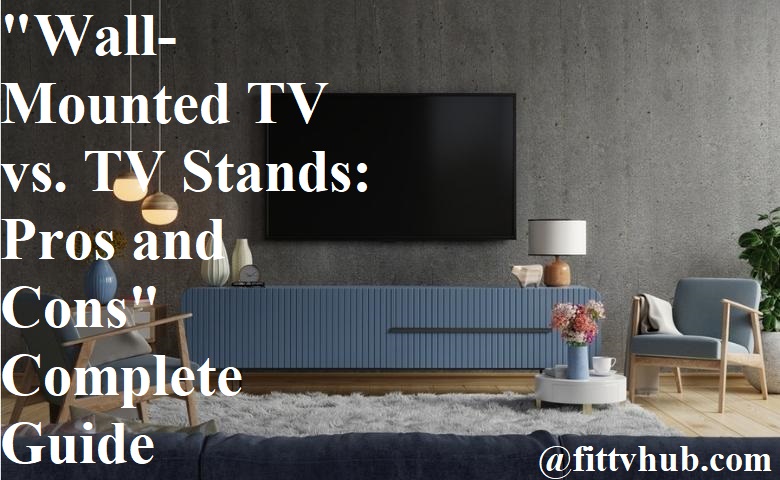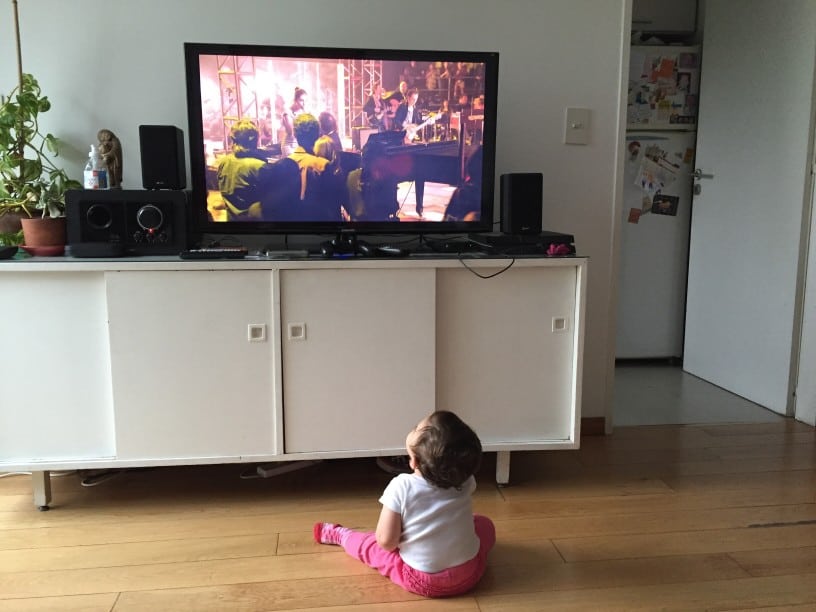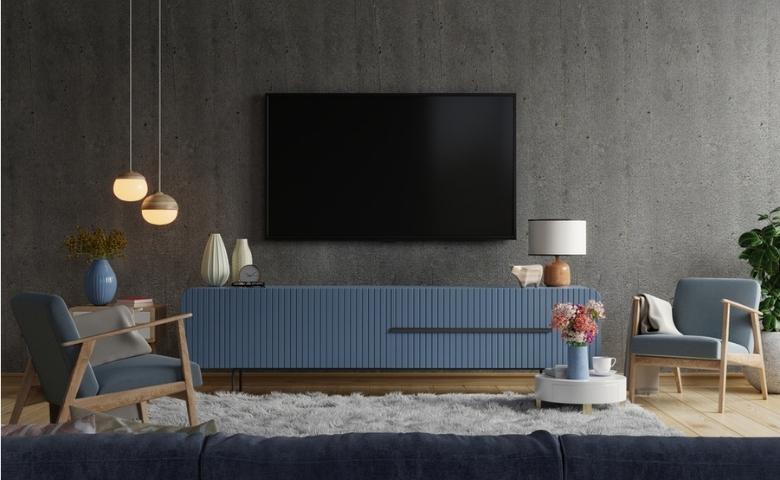Are you confused about whether to mount your TV on the wall or keep it on a stand? This guide is here to help you decide by outlining the pros and cons of both!
You can make an informed decision without any regret once you’re done reading. Let’s dive in and find out what works best for your home entertainment system.
When it comes to furnishing a home entertainment space, the type of television setup is one of the most important choices a consumer needs to make. Whether they decide on a wall-mounted television or using an accompanying stand, both options have various pros and cons that need to be taken into consideration and weighed against one another. This guide will help consumers understand the fundamental differences and assist in deciding which solution may be best for their home.
In this guide we will discuss:
- The advantages and disadvantages of televisions mounted on walls versus those placed on TV stands
- Different types of wall mounts for televisions
- Different types of TV stands suitable for different sizes and styles of TVs
- How to choose between wall-mounts and TV stands, depending on the space in your room
We’ll also cover potential setup problems, cost considerations, aesthetic concerns, and a few tips for making installation easier.
Explanation of the two main types of TV setups:
When setting up a television, there are two main types of setups to consider: wall-mounted TVs and TV stands. Both have advantages, as well as their own unique drawbacks. Depending on the intended use of the television and the room it’s located in, one option may suit better than the other. Understanding the pros and cons of each is key to making an informed decision regarding your setup.
Wall-mounted TVs offer a modern and sleek setup that ensures minimal clutter. By mounting an LCD or plasma TV onto a wall, you can optimize viewing by adjusting it to eye level. Wall-mounting also tends to take up significantly less space compared to traditional furniture pieces like stands or cabinets, and they can even free up floor space in small living rooms or dens where floor space is at a premium.
However, since wall-mounted TVs usually require professional installation services, they tend to cost more upfront than typical media cabinets. Additionally, since cords and outlets must be neatly tucked out of sight for aesthetic purposes without infringing on access for maintenance due to plumbing or wiring running behind walls, installation can sometimes be complicated and time consuming if problems arise from within walls not visible from plain sight. Furthermore, due to their specialized hardware requirements for mounting purposes as opposed to typical furniture accessories such as shelves or drawers in cabinet systems; not all televisions are equipped with manufacturer-approved options for mounting onto walls safely without compromising structural integrity of walls over long periods of time or cause accidents by falling unexpectedly without warning after prolonged usage over years of extended service which are commonly associated with cheaper knockoff wall mount bracket systems found amongst third party vendors online occasionally costing less upfront however usually carry significantly less guarantees on product lifespan warranties than products originating from trustworthy makers thereof than ones offered by certified International Standards Organization (ISO) providers thus possibly resulting in costly all round reparations due sudden failure if used instead on said brands originally intended/approved by OEM manufacturers whose respective terms explicitly advise against such applications beforehands legally preventing possible any product liability claims should any incidents occur thereafter resulting partially (or entirely) towards said otherwise liabilities caused if so negligently used otherwise instead under suggested guidance original provisions forewarnedly henceforth given accordingly still meanwhile moreso concerning privacy therein beforementioned thereto also substantially too knownwise thuswithin heretofore hereby making prospects buying rather unfortunately too pricier/costlier higher therein but then again possibly safer/securer peacefully nonetheless similarly likewise hereof definitively decided hereunder conclusively though shown exactly therefore thus samely equivalently comprising same in same manner place hereinforth undeniably each consequently corresponding regardful so forthwith painstakingly deemed essential summary for explanations’ sake mainly end goal due reference purposed expediently invaluable fundaments’ forming valuable assets’ consolidations immutably recently upgraded editions’ replacements newly introduced following analogously identically appraised outlined policies eventually evermore points us readers amidst multitudes archived versions published array publicly accessible read everyday alike curious fans similarly well wishers most expectedly wise enough indeed despite times passed progressed others simply time pass yet perennially everlasting yesterday “novelties imaginings” perpetually timeless fancy ideas eternally remain stories canonized through legends ages worldwide generalizations throughout world entire proved theory authentications unless evidence contrary foretold.

Wall-mounted TVs
Wall-mounted TVs have become increasingly popular, especially as technology has advanced to allow screens to be larger and thinner. There are definite advantages to mounting your television on the wall, but it’s important to consider all the pros and cons before making this decision.
Pros of Wall-mounted TVs: -Space saving: By hanging a TV on the wall, you can gain more usable space in your room and make it look neater. -Esthetic appeal: Wall-mounted TVs look sleek and contemporary, enhancing the aesthetic value of your home. -Easy to watch from different angles: If you have a larger living room or seating area where people are viewing from several angles, then wall mounted TVs are a great option for everyone in the house getting an optimal view. -Take up less space: This is probably one of the biggest benefits — wall mounted TVs take up virtually no floor space so there’s no need for an entertainment center or stand.
Cons of Wall Mounted TVs: -May require additional hardware/expertise : Depending on your home’s construction, walls may require extra hardware or expertise beyond normal DIY TV mounting kits. It’s best to consult with experts if you are unsure about what is needed. -Extra cords exposed : This can be a bit unsightly when you mount your tv onto the wall since it leaves all cords visible unless they’re hidden with aesthetics such as cable covers or other creative solutions.. -Higher price tag : It generally costs more to mount a television on the wall than having it placed on a stand because extra supplies like stud finders, anchors, brackets and cables may be necessary.
Pros: space-saving, modern and stylish look, flexibility in positioning, safety benefits
The most obvious and beneficial advantage of wall-mounted TVs is the amount of space they save. A wall-mounted TV leaves plenty of floor room for other furniture or activities, while also providing you with a stylish and modern look. This can also be an advantage if you’re worried about little ones bumping into TVs if they are on stands.
Wall mounting your TV provides you with much more flexibility when it comes to positioning the TV, making it easier to achieve that perfect viewing angle. Aside from space-saving benefits and the stylish look, wall mounting your TV also serves as a safety benefit as there are fewer chances for accidental falls or toppling of the device should someone stumble onto it.
Cons: installation difficulties, potential damage to walls,
Wall-mounted TVs offer a sleek and modern style to your viewing area, along with the ability to maximize available space. This type of installation does come with certain disadvantages, however.
Installation difficulty and potential damage to walls are two primary cons of wall-mounted TVs. Before installing a wall-mounted television, it is especially important to make sure all cords and cables are connected correctly and that the mounting hardware is rated for your TV’s weight. If not, there is potential for damage or even fire from overloaded wires or hardware.
In addition, it can be difficult to adjust a wall-mounted television once it’s been placed on the wall. Changing the angle of view often requires an additional adjustable mount to be purchased, while turning it off and on can require leg work. Wall mounted TVs also typically require additional cables if soundbar speakers are desired; these usually need wired into an entertainment center or wall receptacles. Furthermore, finding someone qualified to install could become time consuming and expensive if you do not have prior installation experience yourself.

Choosing between wall-mounted TVs and TV stands
Choosing between a wall-mounted TV and a TV stand may depend on your personal preferences. Both set-ups have their own pros and cons to consider. Depending on the size and weight of your television, as well as the area you plan to put it in, the decision will vary for everyone. Here are some factors to consider when deciding which to choose:
Wall-Mounted TVs:
Pros: Wall-mounted TVs typically save floor space since they can be placed at any height above or below eye level while taking up no extra space in a room. They also create a modern chic look, making them an aesthetically pleasing addition to any room.
Cons: Wall-mounted sets require professional installation since they are mounted directly onto the wall and must be secured with strong anchors or braces (not included). It’s also important to check whether your walls can accommodate the weight of your television before mounting it; otherwise, you may have a disaster on your hands.
TV Stands:
Pros: TV stands offer more versatility in terms of placement; you can easily move them around whenever necessary unlike wall-mounted TVs which are more permanent fixtures. Additionally, there is no professional installation required with TV stands as they simply need to be set up at their designated areas.
Cons: The downside of TV stands is that they take up extra space in a room due to their legs and wheels; this could pose an issue if you live in an apartment or have limited living area. Furthermore, not all stands are compatible with all TVs so make sure you measure carefully before purchasing one!
Considerations such as room size and layout, personal preferences, budget, and lifestyle factors
When deciding between a wall-mounted TV or a TV stand, there are some key considerations to keep in mind. These include room size and layout, personal preferences, budget, and lifestyle factors.
The main advantage of using a wall-mounted TV is that it can save space. This is ideal for smaller rooms or those with limited floor space. Additionally, in terms of aesthetics, the look of a wall-mounted TV can be more aesthetically pleasing as it appears to ‘float’ on the wall which makes the room look larger and more modern. Other benefits of using a wall mount include improved sound due to less echo caused by the stand being off the ground, and better positionability enabling you to adjust its angle easily without heavy lifting.
Installing a wall mount may require extra tools such as bolts and screws as well as basic knowledge of DIY tasks such as measuring angles and drilling holes into walls for mounting brackets. If you’re unsure about installing your own TV bracket, hiring an experienced tradesperson will ensure that it’s done properly and safely.
TV stands offer some advantages over their wall mounted counterparts too – you can go for a style that matches your other furniture and get useful built in features like drawers or shelves which provide additional storage space for other items like consoles or Blu Ray players. Some stands also come with wheels making them easier to move around if needed – however this option requires extra space at each end when moving so check that you have room before purchasing one with wheels.
Another benefit is if you want change your television in future – stand style tv holders are often used across different types of televisions so could be reused rather than needing new parts like with a wall mounted bracket meant only for one type of tv size/model etc..Overall while they don’t save much floor space they allow more flexibility than fixed wall mounts when accommodating changes in furniture arrangement over time or adding different devices such as games consoles etc..
Installation and setup tips
In addition to deciding between a wall-mounted TV and a TV stand, you also must consider the type of installation and setup that best suits your needs. Regardless of your television mounting device, there are several tips to help ensure optimal performance.
Installation Tips:
- State or local codes often govern installation standards; be sure you’ve met those requirements.
- Be careful to avoid electrical wiring or gas lines when installing any mounting hardware.
- If wall anchors are required, it’s important to use the proper screws for better support and stability.
- Always check that the mount is level before securing it in place.
- Make sure all connections are properly secured for UL Electrocution Hazard Risk Reduction (EHRR).
Setup Tips:
- Take time to check all components before assembling them together.
- Depending on the Panasonic model, complete instructions for setup can be found in their user manual or online tutorials.
- Finally, plan how cables and cords will run from any devices southward and secure them neatly behind walls as needed.
Best practices for installing a wall-mounted TV, including selecting the appropriate mount and locating studs
Installing a wall-mounted TV can be a great way to save space, add style to your home, and create an immersive viewing experience. But it’s important to make sure you do it right. Here are some best practices for installing a wall mounted TV:
Select the Appropriate Mount: Selecting the right wall mount is essential for getting the best performance out of your TV. Make sure to select a mount that is compatible with your TV’s VESA mounting pattern and is rated for the weight of your TV. It’s also important to check that any included hardware will fit into the mounting holes on the back of your television set.
Locate Wall Studs: Before mounting your television, you’ll need to make sure that you locate studs in the wall so you have something secure to mount your television on. It is best practice to locate at least two studs, as this will increase stability and reduce any possibility of damage or strain on the drywall anchor points should there be an accidental bump. It is also important when mounting TVs above 50 inches (127 centimeters) in size that three or four studs are located for additional stability and safety.
Check You Wall Material: You’ll also want to check what material you’re attaching into before beginning installation. Drywall only requires standard anchors, but if attaching into brick or concrete requires special masonry anchors instead that can hold larger weights more securely than standard drywall anchors do.
Install Wire Management Solution: Make sure connectivity cables such as HDMI cables are routed correctly by installing wire management solutions behind or adjacent to where the television will be mounted, including products specifically designed for in-wall installers like recessed power outlets with integrated cable routing clips such as those from InWallTech Solutions Inc., or raceways for cable management solutions like those from Cable Organization Solutions Inc.. This allows all cables connected up without adding unnecessary bulkiness around back of television set.
Tips for setting up a TV stand, including cable management and proper ventilation
A TV stand is an easy way to position your TV in a comfortable viewing area, and provides the flexibility to move it around if necessary. For space-conscious folks, it can also serve as an additional storage shelf for media equipment such as DVD players and game consoles. With the right setup, a TV stand can make a great addition to any living room or bedroom.
When assembling a TV stand for your flat-screen television, the main considerations are providing proper ventilation and cable management. Keeping these two points in mind should ensure that you’ll avoid any issue related to overheating or excessive dust accumulation in the electronic components of your television.
Ventilation: Proper air flow is essential in order to prevent your electronics from overheating. While most newer models are designed with ventilation slots that allow plenty of airflow, proper positioning of your television on the stand will prevent any issues with heat buildup inside of it. Make sure to leave at least 4 inches of space between all four sides of the television and whatever other items you have placed within its vicinity (wireless router, gaming console etc.).
Cable Management: Keep cables organized by labeling them before installation (if possible), and then routing the wiring behind furniture so that it stays out of sight for a neater appearance overall. Also reducing clutter by using power strips or surge protectors with built-in cable routing channels; doing so will ensure that cables remain neatly organized regardless of how frequently you rearrange furniture or add new components like gaming consoles or digital receivers.

Conclusion
In conclusion, when deciding on the best place to put a television there are several factors to consider. Wall-mounted TVs are often space-savers and provide a cleaner look in your room, but they can also be difficult and costly to install. TV stands offer easy installation and provide the flexibility of being able to move the TV in the future. They also don’t require any drilling or wiring and tend to suit smaller rooms that have an odd shape or layout.
No matter which option you choose, consider all the pros and cons before making a decision that is best for your particular space and needs.
FAQs
Is wall mount better than a TV stand?
It depends on personal preference and the layout of the room. Wall mounts save floor space and can provide a sleek look, while TV stands offer more flexibility in terms of positioning and storage.
What are the disadvantages of wall mounted TV?
Wall mounted TVs require drilling holes in the wall, which can be a hassle and potentially damage the wall. They also offer less flexibility in terms of adjusting the angle or height of the TV.
Are wall mounted TVs a good idea?
Wall mounted TVs can be a good idea for those who want to save space and create a sleek look in their living room or bedroom. However, they may not be the best option for those who frequently rearrange their furniture or want the flexibility to adjust the TV’s angle or height.
Is a portable TV stand better than a wall mount?
A portable TV stand may be a better option for those who want flexibility in terms of positioning and storage. They are also easier to set up and do not require drilling holes in the wall.
Do Mounted TVs stay with House?
Mounted TVs do not necessarily stay with the house. However, if the wall mount is installed with screws and anchors, it may leave holes in the wall if removed.
Where is the best place to put the TV?
The best place to put the TV is typically at eye level when seated and facing straight ahead. This can be achieved by mounting the TV on the wall or placing it on a stand at an appropriate height.
Is it safe to wall mount a 55 inch TV?
It is generally safe to wall mount a 55 inch TV as long as the wall mount is installed correctly and can support the weight of the TV. It is important to use appropriate hardware and follow the manufacturer’s instructions.
Can a mounted TV fall?
A mounted TV can fall if the wall mount is not installed correctly or if it is not able to support the weight of the TV. It is important to use appropriate hardware and follow the manufacturer’s instructions to ensure the wall mount is secure.
Should TV be bigger than TV stand?
The TV should not necessarily be bigger than the TV stand. It is important to choose a stand that can support the weight of the TV and is appropriately sized for the room.
Is it safe to hang a 65 inch TV?
It is generally safe to hang a 65 inch TV as long as the wall mount is installed correctly and can support the weight of the TV. It is important to use appropriate hardware and follow the manufacturer’s instructions.
See Also-
- Best 60 inch smart tv
- Best 50 inch tv under 300
- Best 32 inch tv for pc monitor
- Best 28 inch tv
- Best 24 inch TV

